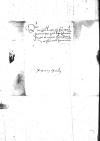Letter #6111
Mauritius FERBER to Ioannes DANTISCUSHeilsberg (Lidzbark Warmiński), 1536-07-21
| received [1536]-07-23 Manuscript sources:
Auxiliary sources:
| ||||||
Text & apparatus & commentary Plain text Text & commentary Text & apparatus
Reverendissimo in Christo Patri et Domino, domino
Reverendissime in Christo Pater et Domine, domine frater et amice carissime plurimumque honorande.
Quid iterum illustrissimus dominus
Non ab re fortasse foret, si Reverendissima Dominatio Vestra, aliis licet verbis, in eum saltem effectum (quo ulterioribus sollicitationibus vacemus) responderet, donec ex communi consilio responsum detur, salvo tamen meliori iudicio Reverendissimae Dominationis Vestrae.
Cui longam et salvam vitam omniumque fortunarum optatissimum successum a Deo precor.
Ex
Vestrae Reverendissimae Dominationis totus bonus frater


 AAWO, AB, D. 8, f.81v
AAWO, AB, D. 8, f.81v